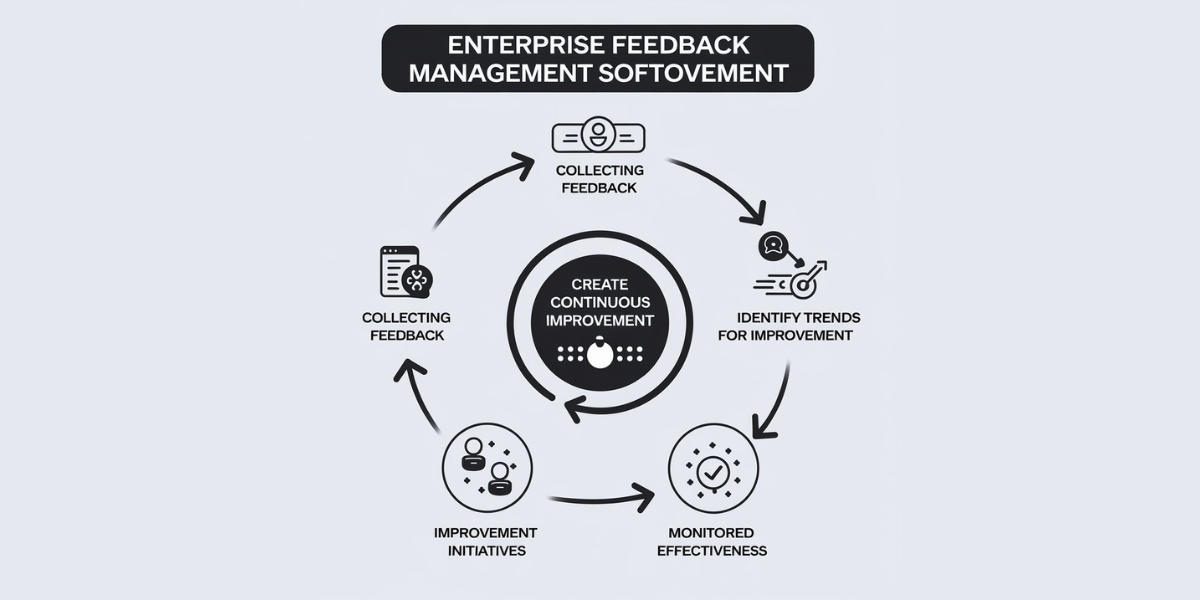Tracking the right metrics is essential for optimizing Enterprise Feedback Management (EFM) Software. These metrics provide actionable insights into customer satisfaction, employee engagement, and overall business performance. By focusing on these key indicators, businesses can make data-driven decisions to enhance their strategies. Moreover, monitoring the right metrics ensures continuous improvement and a competitive edge in the market. But what are the most important metrics, and why do they matter? Let’s explore the key data points to monitor and how they help businesses drive growth and improve experiences with Enterprise Feedback Management.
Why Track Metrics Using Enterprise Feedback Management Software?
EFM software empowers businesses to collect and analyze feedback systematically. Tracking metrics ensures organizations can:
- Understand Customer Needs: Identify trends in preferences and address problem areas.
- Measure Performance: Evaluate the success of services or strategies using quantifiable data.
- Drive Continuous Improvement: Leverage insights to refine operations and enhance outcomes.
Without tracking key metrics, feedback becomes underutilized, hindering decision-making and improvements. EFM software ensures businesses turn raw data into actionable insights that inform strategic growth.
Key Metrics to Track for Customer Feedback
Customer Satisfaction Score (CSAT)
CSAT measures how satisfied customers are with your product, service, or experience. It’s typically collected through surveys using a simple scale, such as 1-5 or 1-10. High CSAT scores indicate positive interactions, while low scores highlight areas that need immediate attention.
Net Promoter Score (NPS)
NPS assesses customer loyalty by asking, “How likely are you to recommend us?” Respondents score their likelihood from 0-10. Scores between -100 to 100 show overall sentiment, with higher scores reflecting stronger loyalty. Tracking NPS over time helps businesses evaluate customer perception and brand advocacy.
Customer Effort Score (CES)
CES measures the ease with which customers interact with your business or resolve issues. Customers rate their experience based on how much effort they had to exert. Lower effort correlates with higher satisfaction, making CES a vital metric for improving processes.
Churn Rate
The churn rate tracks how many customers leave your business over a given time period. High churn indicates dissatisfaction or unmet needs. By analyzing feedback through EFM tools, businesses can address churn drivers and implement changes to retain customers.
Key Metrics to Track for Employee Feedback
Employee Satisfaction Score (eNPS)
Similar to NPS, eNPS gauges employee satisfaction and loyalty by asking how likely employees are to recommend their workplace. This metric provides insights into team morale, helping organizations enhance workplace culture and engagement.
Engagement Levels
Engagement metrics evaluate how invested employees are in their roles and the company’s success. Feedback highlights factors like leadership, work-life balance, and opportunities for growth that influence engagement. High engagement often correlates with better performance and retention.
Turnover Rate
Tracking turnover rates reveals how often employees leave the company. EFM software allows businesses to analyze why employees leave, uncovering areas for improvement such as compensation, recognition, or development opportunities.
Advanced Metrics Enabled by EFM Software
Sentiment Analysis
EFM systems equipped with AI-powered sentiment analysis decode emotions in open-ended responses. This helps businesses understand customer or employee feelings beyond numerical scores, providing nuanced insights into satisfaction and frustrations.
First-Contact Resolution (FCR)
FCR measures the percentage of customer issues resolved during the first interaction. A high FCR indicates effective support processes and contributes to greater customer satisfaction.
Response Rates
Response rates measure how many customers or employees participate in feedback collection. High response rates suggest well-designed and engaging surveys, while low rates might indicate survey fatigue or disinterest.
How to Use Metrics for Continuous Improvement
- Analyze Trends: Use EFM software to track metrics over time and identify patterns or recurring issues.
- Segment Data: Break feedback into categories, such as customer demographics or product types, to uncover targeted insights.
- Act on Feedback: Use survey results to make meaningful changes and demonstrate responsiveness.
- Close the Loop: Follow up with stakeholders to show you’ve addressed their concerns and applied their feedback.
Best Practices for Tracking Metrics with EFM Software
- Set Clear Goals: Define objectives for tracking metrics, such as improving satisfaction or reducing churn.
- Leverage Automation: Use automated data collection and real-time analytics for faster, more accurate insights.
- Customize Surveys: Ensure surveys address your specific business needs for actionable results.
- Monitor in Real-Time: Regularly review dashboards and analytics to react promptly to issues or trends.
Why is employee feedback important in EFM?
Employee feedback helps improve workplace culture, engagement, and retention, which positively impacts customer satisfaction.
What tools are commonly used to track feedback metrics?
Popular tools like Qualtrics, Medallia, and SurveyMonkey Enterprise offer robust features for tracking feedback metrics effectively.
How do I ensure high survey response rates?
To improve response rates, keep surveys concise, use clear language, and explain the value of participation.
Can EFM metrics predict customer behavior?
Yes, metrics like NPS and churn rate can provide predictive insights into loyalty and retention, enabling proactive strategies.
What’s the difference between NPS and eNPS?
NPS measures customer loyalty, while eNPS evaluates employee satisfaction and workplace advocacy.
Conclusion
Tracking key metrics using Enterprise Feedback Management Software is essential for improving customer and employee experiences. Metrics like CSAT, NPS, CES, and eNPS offer valuable insights into satisfaction, loyalty, and engagement. By leveraging these data points, businesses can identify pain points, implement meaningful changes, and foster long-term success.




